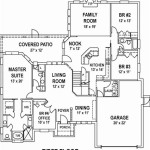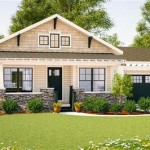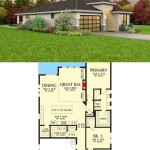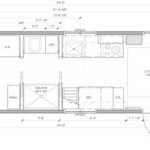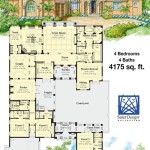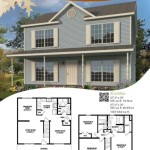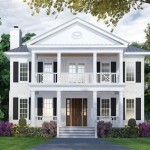Simple 1 Bedroom Apartment Floor Plans With Dimensions
A one-bedroom apartment offers a compact and manageable living space, ideal for individuals, young professionals, or couples seeking an economical housing solution. Understanding the dimensions and layout options available is crucial for maximizing the functionality and comfort of these spaces. This article delves into the realm of simple one-bedroom apartment floor plans, providing insights into typical dimensions, common layout variations, and strategies for optimizing space utilization.
The term "simple" refers to floor plans that prioritize efficiency and ease of navigation, often featuring rectilinear shapes and minimal architectural complexities. While aesthetic preferences vary, functional floor plans consistently prioritize a logical flow between spaces, adequate storage, and sufficient natural light. The availability of precise dimensions empowers prospective tenants and homeowners to accurately assess whether their furniture and lifestyle align with the apartment's spatial constraints.
Understanding Typical Dimensions of a One-Bedroom Apartment
The dimensions of a one-bedroom apartment can vary significantly depending on location, building type, and design. However, some general guidelines can be established. The total square footage typically ranges from 500 to 800 square feet, although smaller and larger units exist. Within this overall area, the space is divided into several distinct zones: living area, kitchen, bedroom, bathroom, and sometimes a small dining area or balcony.
The living area, often the largest single space in the apartment, typically measures between 150 and 250 square feet. Its dimensions are crucial for accommodating seating arrangements, entertainment systems, and general circulation. The kitchen area, which may be open to the living room or separated, varies considerably. Kitchens in smaller apartments may be confined to a galley style, while larger units might feature a U-shaped or L-shaped layout, providing more counter space and storage. The kitchen area typically consumes 50 to 100 square feet depending on its design.
The bedroom typically ranges from 100 to 150 square feet, sufficient for a queen-sized bed, a dresser, and potentially a small desk. The placement of windows and the orientation of the bedroom within the overall floor plan are critical factors for ensuring adequate natural light and ventilation. The bathroom, usually the smallest dedicated room, typically occupies 35 to 50 square feet. The bathroom's layout includes essential elements such as a toilet, sink, and shower or bathtub. In some cases, the bathroom may also house the washing machine and dryer.
In addition to the main living areas, hallways and entryways also contribute to the overall square footage. These transitional spaces, while often overlooked, play a vital role in connecting the different rooms and providing opportunities for storage solutions. Closets, both in the bedroom and elsewhere in the apartment, are essential for maintaining organization and minimizing clutter. Their size and placement should be carefully considered when evaluating a floor plan. Balconies, if present, can add valuable outdoor living space. Their dimensions can vary widely, from small Juliet balconies to larger terraces suitable for outdoor dining and relaxation.
Exploring Common One-Bedroom Apartment Floor Plan Layouts
Several common floor plan layouts cater to the specific needs and preferences of residents. These layouts can be broadly categorized based on the relative placement of the main living areas and the overall shape of the apartment.
A linear layout, also known as a railroad-style apartment, features all the rooms arranged in a straight line, one after the other. This layout is common in older buildings and often maximizes space utilization within a narrow footprint. However, it can sometimes lack a clear separation between the living and sleeping areas. A central hallway layout places the living area and bedroom on either side of a central corridor leading from the entrance. This layout provides more privacy for the bedroom while maintaining a clear sense of separation between the different function areas.
Open-concept layouts are increasingly popular, particularly in modern apartment buildings. These layouts minimize the use of walls, creating a more spacious and airy feel. The living area and kitchen are often combined into a single large room, with the bedroom separated by a wall or partial divider. Open-concept layouts promote social interaction and maximize natural light penetration but may require careful attention to furniture placement and zoning to define distinct functional areas.
Corner units offer the advantage of having windows on two exterior walls, providing more natural light and potentially better views. The floor plan of a corner unit is often shaped to maximize the benefits of this dual exposure, with the living area and bedroom typically located along the exterior walls. Due to their desirable characteristics, corner units often command a higher rent or purchase price.
Another variation involves a split-bedroom layout, which places the bedroom on one side of the apartment and the living area on the other, with the bathroom and kitchen typically located in between. This layout provides maximum privacy for the bedroom and can be particularly appealing to roommates or couples who desire separate living spaces. The placement of the entrance is a crucial consideration in any floor plan. An entrance that opens directly into the living area can create a more welcoming and spacious feel, while an entrance that leads into a hallway provides more privacy and can help to contain noise and drafts.
Strategies for Optimizing Space Utilization in a One-Bedroom Apartment
Given the limited square footage of a one-bedroom apartment, optimizing space utilization is essential for creating a comfortable and functional living environment. Several strategies can be employed to maximize storage, minimize clutter, and enhance the overall sense of spaciousness.
Multifunctional furniture is a key component of space-saving design. Items such as sofa beds, storage ottomans, and folding tables can serve multiple purposes, freeing up valuable floor space. Vertical storage solutions, such as shelving units that extend to the ceiling, can also maximize storage capacity without occupying additional floor area. Mirrors can be strategically placed to create the illusion of more space and amplify natural light.
Wall-mounted shelves and cabinets are useful for storing books, decorative items, and other belongings without taking up floor space. Under-bed storage containers provide a convenient way to store out-of-season clothing, linens, and other items. Organizing closets efficiently can significantly increase storage capacity, utilizing shelf dividers, hanging organizers, and vacuum-sealed bags to maximize space. Employing a minimalist approach to décor can also help to create a less cluttered and more spacious feel. Avoiding excessive furniture and decorative items can make the apartment feel larger and more comfortable.
Proper lighting plays a vital role in creating a welcoming and functional living space. Natural light should be maximized by keeping windows clean and using sheer curtains or blinds that allow light to filter through. Artificial lighting can be used to supplement natural light and create different moods and atmospheres. Layering various types of lighting, such as ambient, task, and accent lighting, can enhance the functionality and aesthetics of the apartment.
Finally, maintaining a regular decluttering routine is essential for keeping the apartment organized and spacious. Regularly purging unwanted items and organizing belongings can prevent clutter from accumulating and ensure that the space remains functional and comfortable. Utilizing vertical space, employing multi-functional furniture, and maintaining a clutter-free environment are key to maximizing the liveability of any one-bedroom apartment.

One Bedroom Style F Waterfront Apartments

50 One 1 Bedroom Apartment House Plans Architecture Design

1 Bedroom Apartment Plan Examples

Apartments Country Charm

Studio Apartment Floor Plans Google Search

Free Editable Apartment Floor Plans Edrawmax

One Bedroom Apartment Floor Plans Ovation 309

Simple One Bedroom Studio Apartment Id 11107 Plan By Maramani Com

Krug Stylish And Simple One Bedroom Atlanta Apartments

Pin Page
Related Posts

